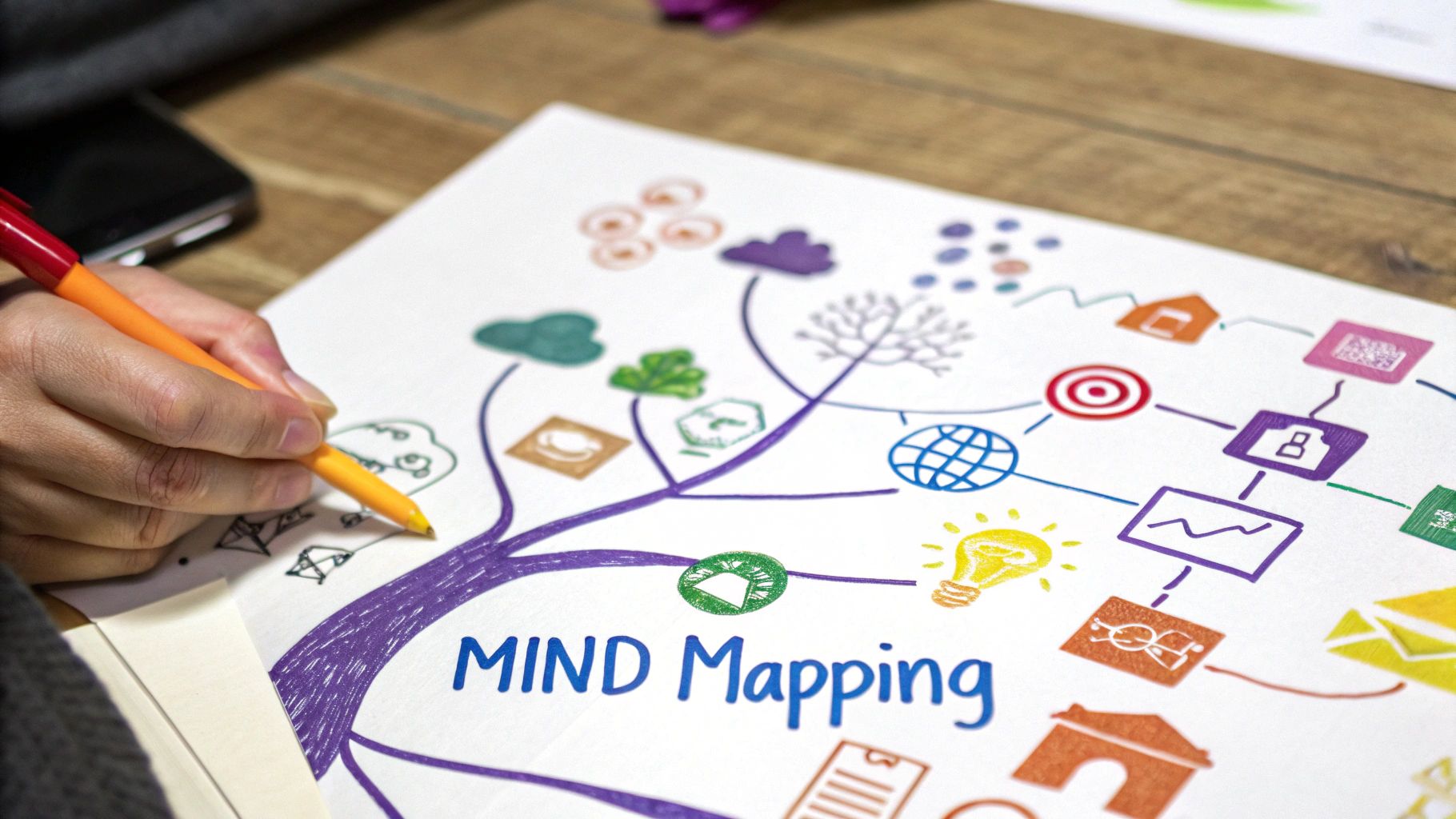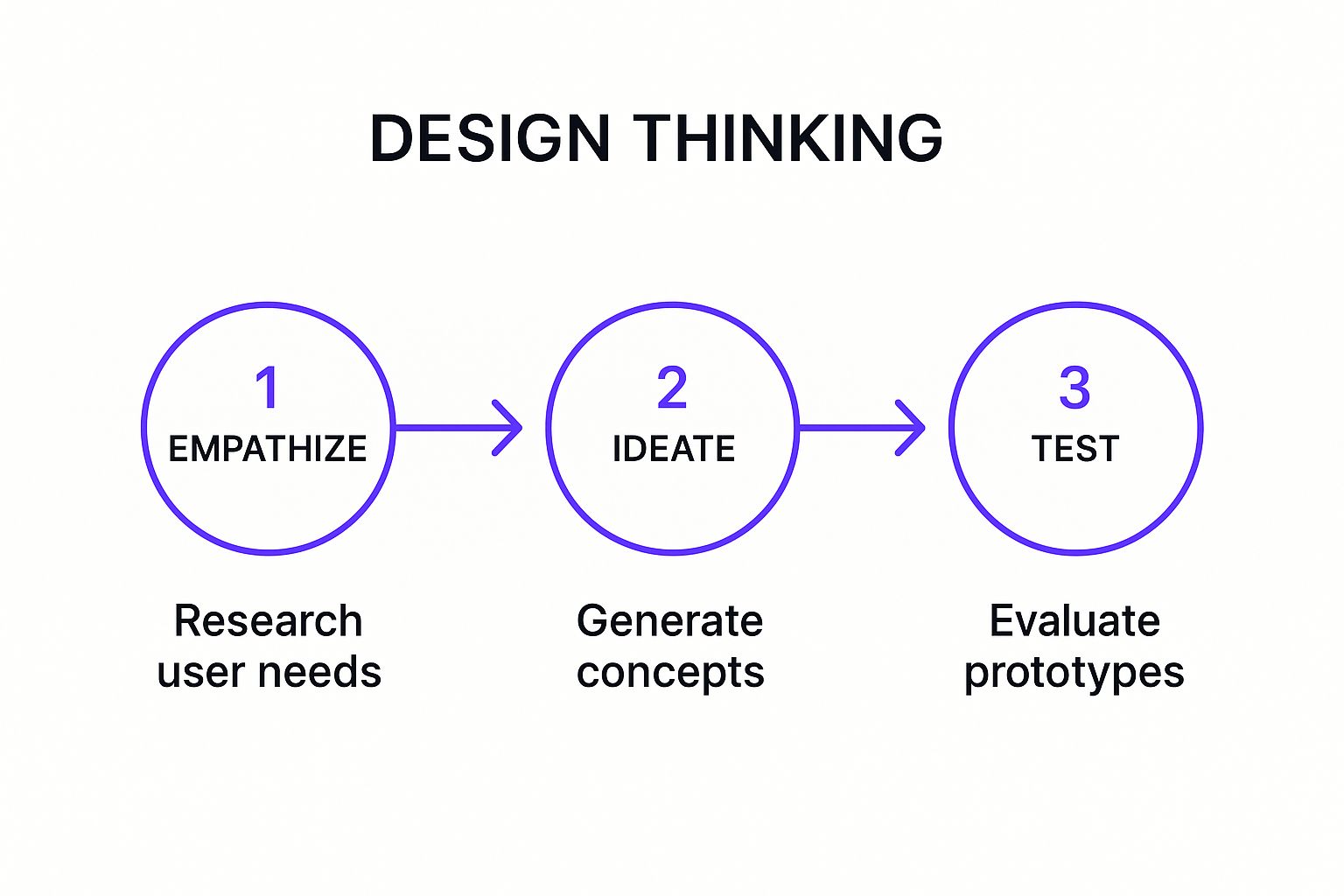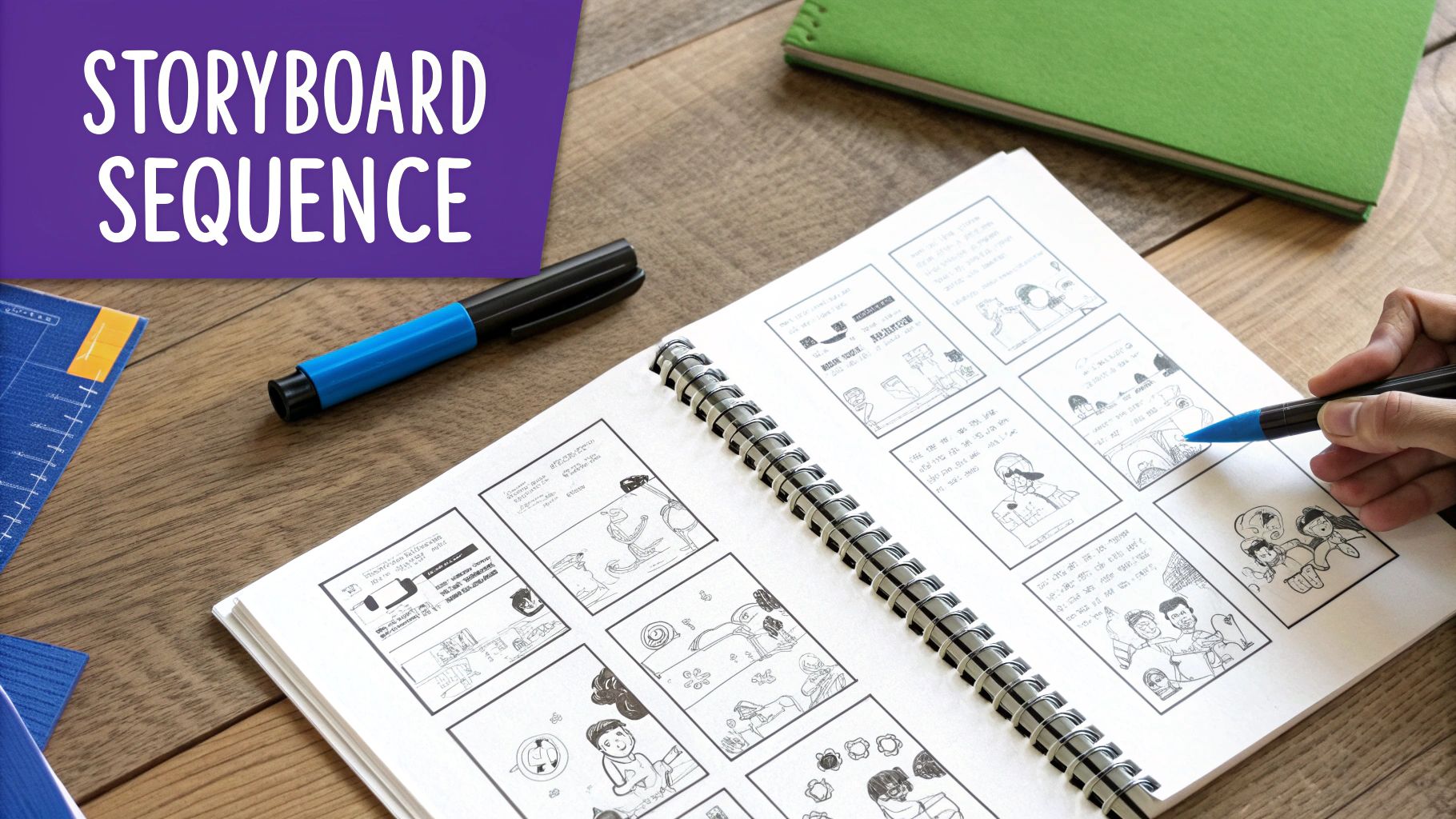In today's distributed workforce, the challenge isn't a lack of talent, but a lack of connection and structure for creativity. Spontaneous whiteboard sessions and casual water-cooler chats have been replaced by scheduled video calls and asynchronous messages. This new reality demands a more intentional approach to innovation. How can remote and hybrid teams capture the same creative spark that once fueled in-person collaboration?
The answer lies in adopting structured idea generation methods specifically adapted for the virtual environment. These techniques provide the framework needed to overcome common remote work hurdles like communication silos, unequal participation, and digital fatigue. To further facilitate creative output, a comprehensive team building personality assessment can also help boost collaboration and understanding within your group.
This guide will explore 10 powerful methods, from Brainstorming and Mind Mapping to the SCAMPER Technique and Design Thinking. We'll move beyond generic advice to provide actionable strategies that ensure every voice is heard and every great idea is captured, no matter where your team members are located. You will get practical steps and digital-friendly tips to transform your team's ideation process and unlock its full creative potential.
1. Brainstorming: The Classic, Reimagined for Remote Teams
Brainstorming is the foundational idea generation method where a group spontaneously contributes ideas around a specific topic. The core principle is quantity over quality, deferring all judgment to encourage a free flow of thought. For remote teams, the challenge isn't the concept but the execution. Success requires translating the high-energy, in-person dynamic to a virtual space using digital tools and structured facilitation.
This method is perfect for the initial stages of a project when you need to explore a wide range of possibilities without immediate constraints.
How to Implement Remote Brainstorming
Adapting this classic technique involves a few key steps to ensure everyone, regardless of their location, can contribute effectively.
- Set the Stage: Use a shared digital whiteboard (like Miro or Mural) as your central hub. Create a clear prompt or "How Might We…" question to focus the session.
- Silent Idea Generation: Begin with 5-10 minutes of silent, individual brainstorming. Each person adds ideas to the board on digital sticky notes. This prevents groupthink and gives introverted team members a comfortable way to contribute.
- Share and Cluster: Go around the virtual room, with each person briefly explaining their ideas. As you go, the facilitator groups similar concepts into thematic clusters.
- Discuss and Refine: Once all ideas are shared and grouped, open the floor for discussion. The team can then build upon the clustered themes, combining or refining concepts.
Key Insight: The initial "silent" phase is the most critical adaptation for remote brainstorming. It democratizes idea submission, ensuring the loudest voice doesn't dominate the session and all perspectives are captured.
2. Mind Mapping: Visualizing Connections for Deeper Insight
Mind mapping is a powerful visual thinking tool that organizes information around a central concept. Starting with a single topic in the center, you draw branches outward to connect related ideas, sub-topics, and keywords. This non-linear approach mimics how our brains naturally associate thoughts, making it an excellent idea generation method for exploring complex problems and uncovering hidden connections.
This technique is ideal when you need to structure your thoughts, break down a large topic into manageable parts, or see the relationships between different pieces of information. For instance, Boeing famously used mind mapping to streamline complex aircraft design processes.

How to Implement Mind Mapping
Creating an effective mind map involves more than just jotting down ideas; it’s about creating a visual hierarchy that stimulates creative thinking.
- Establish a Central Theme: Start with a central image or a single, powerful word that represents your main topic. Place this in the middle of your digital canvas or physical page.
- Branch Out with Keywords: Create main branches radiating from the center for your primary themes. Use single keywords or very short phrases for each branch to keep the map clean and scannable.
- Add Sub-Branches: From your main branches, extend smaller sub-branches for supporting details, tasks, or further ideas. Use different colors for major themes to visually distinguish them.
- Incorporate Visuals: Enhance your map with symbols, icons, and small images. Visual cues are processed faster by the brain and can trigger new associations and ideas.
Key Insight: The use of single keywords and images, rather than long sentences, is what makes mind mapping so effective. It frees your mind from the constraints of linear, sentence-based thinking and encourages a more rapid and associative flow of ideas.
3. SCAMPER Technique: A Systematic Approach to Innovation
The SCAMPER technique is a structured checklist method for creative thinking, using seven prompts to systematically modify an existing product, service, or process. Developed by Bob Eberle, it builds on the work of brainstorming originator Alex Osborn. The acronym stands for: Substitute, Combine, Adapt, Modify, Put to another use, Eliminate, and Reverse.
This method is ideal when you need to improve an existing concept or solve a specific problem, rather than starting from a blank slate. It provides a focused framework that guides your team through tangible pathways for innovation, making it one of the most practical idea generation methods available. For example, Uber essentially Combined taxi services with mobile app technology.
How to Implement the SCAMPER Technique
Applying SCAMPER involves methodically asking questions related to each of the seven prompts about your existing idea or product.
- Define Your Focus: Clearly identify the existing product, service, or problem you want to innovate on. Write it at the top of a digital whiteboard or shared document.
- Work Through the Acronym: Create seven sections, one for each letter of SCAMPER. As a team, brainstorm questions and ideas for each prompt (e.g., for Substitute: "What materials or people can we swap?").
- Document Everything: Capture all ideas generated under each letter without immediate judgment. The goal is to generate a large volume of potential modifications.
- Evaluate and Select: After working through all seven prompts, review the generated ideas. Identify the most promising concepts to explore further through prototyping or discussion.
Key Insight: The true power of SCAMPER is its systematic nature. It forces your team to look at a problem from seven distinct angles, preventing mental blocks and revealing innovative possibilities that a more open-ended brainstorm might miss.
4. Six Thinking Hats: A Framework for Structured Thinking
Six Thinking Hats is a parallel thinking technique developed by Edward de Bono. It encourages teams to look at a problem from six distinct perspectives, represented by colored hats. Instead of debating, the entire group wears the same "hat" at the same time, ensuring a comprehensive and conflict-free exploration of an idea. For instance, IBM has used this method for strategic planning and Siemens for product development.
This method is ideal when a team is stuck in a debate or needs to evaluate a complex idea thoroughly without emotional bias, making it one of the most effective idea generation methods for late-stage refinement.
How to Implement Six Thinking Hats
This structured approach ensures all angles are covered systematically, making it excellent for remote teams where nuanced discussion can be difficult.
- Assign the Hats: Introduce the six hats and their corresponding thinking modes:
- White Hat: Facts and data. What information do we have?
- Red Hat: Emotions and intuition. What are our gut feelings?
- Black Hat: Caution and risks. What could go wrong?
- Yellow Hat: Benefits and optimism. Why will this work?
- Green Hat: Creativity and new ideas. What are the possibilities?
- Blue Hat: Process and control. What is our focus? What's next?
- Focus on One Hat at a Time: The facilitator (wearing the Blue Hat) guides the team to "wear" one hat at a time. The team spends 2-5 minutes collectively thinking and contributing ideas only from that hat's perspective.
- Capture Everything: Use a digital whiteboard or a shared document, creating separate columns for each hat. Meticulously record all points raised under the corresponding hat color.
- Sequence and Summarize: The facilitator decides the sequence of hats. A common sequence is Blue, White, Green, Yellow, Black, Red, and a final Blue to summarize and decide on next steps.
Key Insight: The power of this method is its "parallel thinking" nature. By having everyone focus on the same perspective simultaneously, it eliminates unproductive arguments and ensures a balanced evaluation, turning potential conflict into collaborative exploration. You can find more structured frameworks and exercises at RemoteSparks.
5. Design Thinking: A Human-Centered Innovation Framework
Design Thinking is a solutions-focused, human-centered approach to innovation. It integrates user needs, technological possibilities, and business requirements into a structured five-stage process: Empathize, Define, Ideate, Prototype, and Test. It’s one of the most powerful idea generation methods for complex problems where the solution isn't immediately obvious.
This method is ideal when developing new products, services, or features, as it ensures the final output is deeply rooted in what users actually want and need. It’s how companies like Apple and Airbnb continuously create user-centric breakthroughs.
How to Implement Design Thinking Remotely
Executing the five stages of Design Thinking with a distributed team requires a deliberate approach and the right digital tools to foster empathy and collaboration.
- Empathize & Define: Conduct user interviews via video calls and record them for analysis. Use a shared document or digital whiteboard to collaboratively synthesize findings and craft a precise problem statement.
- Ideate: Run a virtual ideation session using techniques like Brainstorming or SCAMPER on a platform like Miro. The goal is to generate a high volume of potential solutions to the defined problem.
- Prototype & Test: Create low-fidelity digital prototypes using tools like Figma or even simple slide decks. Share these prototypes with real users during moderated remote usability testing sessions to gather feedback.
This infographic highlights the core loop of the Design Thinking process.

The visualization shows that successful innovation starts with understanding people, moves to generating ideas, and ends with testing those ideas in the real world. For a deeper dive, you can use a structured Design Thinking workshop template to guide your team through each step.
Key Insight: The power of Design Thinking lies in its iterative nature. The process isn't linear; insights from the "Test" phase often send you back to "Ideate" or even "Empathize" to refine your understanding, ensuring the final solution is truly effective.
6. Lateral Thinking: Solving Problems by Sidestepping Logic
Lateral Thinking is an idea generation method that involves deliberately abandoning traditional, step-by-step logic to solve problems from completely new angles. Popularized by Edward de Bono, it encourages you to challenge assumptions and explore non-obvious paths. Instead of digging the same hole deeper, you start digging somewhere else entirely, making it a powerful technique for breaking through creative blocks.
This approach is ideal when conventional solutions have failed or when you need a truly disruptive innovation, like when Tesla challenged auto industry norms with its direct-to-consumer sales model.
How to Implement Lateral Thinking
Fostering this creative mindset within a team requires structured exercises that force a shift in perspective.
- Challenge Every Assumption: Start by listing all the "given" truths about your problem or product. For each one, ask: "What if the opposite were true?" This deliberate challenging opens up new possibilities.
- Use Random Word Stimulation: Pick a random noun (e.g., "cloud," "bicycle," "river") from a dictionary or generator. Force connections between that word and your problem to trigger unexpected ideas.
- Apply Provocation Techniques: Introduce a provocative or seemingly illogical statement, such as "Our customers don't need customer service." Then, use that statement as a stepping stone to generate practical, innovative ideas for improving service.
- Seek Analogies from Unrelated Fields: Look at how a completely different industry, like nature or entertainment (think Cirque du Soleil reimagining the circus), solved its own unique challenges and see if you can adapt its principles.
Key Insight: Lateral Thinking's power comes from its disciplined approach to creativity. It’s not just about "thinking outside the box"; it's about using specific, structured tools to methodically dismantle the box itself.
7. The 6-3-5 Method: Structured Brainwriting for High-Volume Ideation
The 6-3-5 Method is a structured brainwriting technique designed for rapid, high-volume idea generation. The formula is simple: 6 participants each write down 3 ideas in 5 minutes. After each five-minute round, they pass their worksheets to the person next to them, who then builds upon or adds to the existing ideas. This systematic process generates an impressive 108 ideas in just 30 minutes.
This highly structured approach is ideal when you need to generate a large quantity of refined ideas quickly, making it a powerful tool for teams at companies like Volkswagen and Siemens. It encourages building on concepts rather than just listing new ones, fostering collaborative development from the very start.
How to Implement the 6-3-5 Method
Adapting this classic technique, originally developed by Bernd Rohrbach, for a remote or hybrid setting is straightforward with digital tools.
- Prepare the Grid: Create a shared spreadsheet or digital whiteboard (like Google Sheets or Miro) with a grid. It should have six columns (for the six participants) and multiple rows for the ideas and subsequent rounds.
- Round 1 – The First 5 Minutes: Each of the six participants silently types their first three distinct ideas into the top three cells of their assigned column. A timer is crucial here to maintain pace.
- Rotate and Build: After five minutes, everyone "passes" their column by moving to the one on their right. In the next five-minute round, they read the ideas above and add three new ideas inspired by or building upon them.
- Repeat Until Complete: Continue this process for a total of six rounds. By the end, each participant will have contributed to every column, and the grid will be full of interconnected ideas.
Key Insight: The true power of the 6-3-5 method lies in its constraint-driven creativity. The strict time limit and the requirement to build on others' thoughts force participants to move beyond their initial biases and explore new conceptual territory, leading to more innovative solutions.
8. Morphological Analysis: Systematically Uncovering Every Possibility
Morphological Analysis is a structured idea generation method for deconstructing a complex problem into its core attributes. Popularized by astrophysicist Fritz Zwicky, it involves mapping out all the independent parameters of a problem and then exploring every possible combination of these parameters to discover novel solutions. This systematic approach ensures that no potential solution is overlooked, making it highly effective for complex technical or design challenges.
This method is ideal when you need to innovate within a defined system, like developing a new product feature or improving a multi-part process, and want to explore the full spectrum of options methodically.
How to Implement Morphological Analysis
This technique transforms a daunting problem into a manageable matrix of possibilities, which is perfectly suited for asynchronous collaboration in a remote setting.
- Define the Problem and Parameters: Clearly state the problem you are trying to solve. Identify the fundamental, independent dimensions or attributes of that problem. For example, for a new coffee cup, parameters could be Material, Lid Type, and Insulation Method.
- Create the Morphological Box: Set up a grid or table, often called a "morphological box," in a shared document or spreadsheet. List the parameters as column headers.
- List Variations: Under each parameter, list all possible variations or values. For Material, this could include ceramic, glass, plastic, and stainless steel.
- Explore Combinations: Systematically create new combinations by selecting one variation from each column. Encourage the team to explore both logical and unconventional pairings to generate a vast number of new ideas. A "stainless steel, screw-on, vacuum-insulated" cup is one combination.
Key Insight: The power of Morphological Analysis lies in its ability to force non-linear thinking. By deliberately combining seemingly unrelated elements (e.g., a "bamboo, straw-lid, air-insulated" cup), teams can break free from established patterns and uncover truly innovative concepts that brainstorming might miss.
9. Osborn's Checklist: A Systematic Approach to Innovation
Osborn's Checklist is a structured creative thinking tool developed by Alex Osborn, the originator of brainstorming. It uses a series of action-oriented questions to prompt new ideas by encouraging you to modify an existing product, service, or process. Instead of waiting for inspiration, this method provides a systematic path to innovation.
This technique is exceptionally effective when you have an existing concept that needs improvement or a fresh perspective. It's ideal for product development, process optimization, or refining a marketing campaign, providing a clear framework for focused idea generation.
How to Implement Osborn's Checklist
Applying this checklist involves systematically working through a set of key questions, often remembered by the acronym SCAMPER (though the original list is slightly different).
- Define Your Subject: Clearly identify the existing product, idea, or problem you want to improve. This could be anything from a mobile app feature to your team's weekly meeting structure.
- Ask the Core Questions: Go through the checklist one by one, applying each question to your subject. The classic questions include:
- Put to other uses? Can it be used in a new way or market?
- Adapt? What else is like this? What other idea does this suggest?
- Modify? Change meaning, color, motion, sound, form?
- Magnify? Add something? Make it stronger, larger, or more frequent?
- Minify? Make it smaller, lighter, or remove something?
- Substitute? Who else instead? What else instead?
- Rearrange? Interchange components? Change the pattern or layout?
- Reverse? Transpose positive and negative? Turn it backward or upside down?
- Combine? Combine units, purposes, or ideas?
- Capture All Ideas: Record every single idea generated from each question, no matter how impractical it seems at first. The goal is to create a large volume of raw material.
- Review and Select: After working through the entire list, review the generated ideas to identify the most promising ones for further development and evaluation.
Key Insight: The power of Osborn's Checklist lies in its forced questions. By systematically pushing your thinking in directions you wouldn't naturally go, it breaks down mental blocks and uncovers non-obvious solutions hidden within an existing idea.
10. Storyboarding: Visualizing the User's Journey
Storyboarding is a powerful visual idea generation method that maps out a process, user experience, or narrative through a sequence of images or sketches. Originally pioneered by Walt Disney for animated films, this technique is now essential in UX design, product development, and service innovation for its ability to bring abstract concepts to life.

This method is ideal when your idea is tied to a user’s experience or a complex workflow. It forces you to think sequentially and consider the emotional and practical aspects of how someone will interact with your product or service. Airbnb famously used storyboarding to map and improve the entire host and guest journey.
How to Implement Storyboarding
You don’t need to be an artist to storyboard effectively. The focus is on clarity and sequence, not artistic skill.
- Define the Narrative: Start with a clear beginning, middle, and end. Identify the user (protagonist), their goal, and the scenario you are exploring.
- Sketch Key Moments: On individual cards, sticky notes, or digital frames, draw the critical steps in the user's journey. Keep sketches simple and focus on the action and emotion in each frame.
- Add Context: Below each sketch, add a short description of what is happening and what the user is thinking or feeling. This adds a crucial layer of empathy to the idea.
- Review and Iterate: Arrange the frames in sequence on a wall or digital board. Walk through the story as a team, identify gaps or pain points, and rearrange or add frames to refine the flow. Looking ahead, understanding how AI is revolutionizing no-code platforms can provide new digital tools to bring these storyboards to life even faster.
Key Insight: Storyboarding shifts the focus from "what" the product does to "how" a person experiences it. This human-centered perspective is invaluable for uncovering usability issues and emotional hooks early in the design process.
10 Methods Idea Generation Comparison
| Method | Implementation Complexity 🔄 | Resource Requirements ⚡ | Expected Outcomes 📊 | Ideal Use Cases 💡 | Key Advantages ⭐ |
|---|---|---|---|---|---|
| Brainstorming | Low 🔄 | Low ⚡ | Many diverse ideas 📊 | Early idea generation, team creativity 💡 | Encourages creativity and collaboration ⭐ |
| Mind Mapping | Medium 🔄 | Low to Medium ⚡ | Visual idea organization 📊 | Visual learners, concept connection 💡 | Engages logical & creative thinking ⭐ |
| SCAMPER Technique | Medium 🔄 | Low ⚡ | Practical, improved ideas 📊 | Product improvements, concept refinement 💡 | Systematic and easy to apply ⭐ |
| Six Thinking Hats | Medium to High 🔄 | Medium ⚡ | Balanced perspectives 📊 | Decision making, comprehensive analysis 💡 | Reduces conflict, improves quality ⭐ |
| Design Thinking | High 🔄 | High ⚡ | User-centered innovation 📊 | Complex product/service design 💡 | Empathy-driven, reduces risk ⭐ |
| Lateral Thinking | Medium 🔄 | Low ⚡ | Innovative breakthroughs 📊 | Challenging assumptions, breakthrough ideas 💡 | Breaks mental blocks, fosters innovation ⭐ |
| The 6-3-5 Method | Medium 🔄 | Low ⚡ | Large quantity of ideas 📊 | Structured group ideation 💡 | Prevents dominance, detailed written record ⭐ |
| Morphological Analysis | High 🔄 | Medium to High ⚡ | Comprehensive solution sets 📊 | Complex, multi-dimensional problems 💡 | Systematic coverage of possibilities ⭐ |
| Osborn's Checklist | Low to Medium 🔄 | Low ⚡ | Thorough idea exploration 📊 | Product/service modification 💡 | Structured and detailed approach ⭐ |
| Storyboarding | Medium 🔄 | Medium ⚡ | Clear process visualization 📊 | User experience, process mapping 💡 | Makes abstract ideas concrete ⭐ |
From Ideas to Impact: Making Creativity a System, Not an Accident
Generating great ideas is only the first step. The true challenge lies in creating a repeatable system that consistently fosters innovation within your remote or hybrid team. The idea generation methods we've explored are the building blocks of that system. By moving away from unstructured, free-for-all brainstorming and adopting intentional, guided techniques, you create an environment where every team member can contribute their best thinking.
The key is to choose the right method for your specific challenge. Whether you need the structured critique of the Six Thinking Hats, the visual clarity of Mind Mapping, or the rapid iteration of the 6-3-5 Method, the right framework can transform a frustrating creative block into a breakthrough moment. The goal is to make creativity a reliable process, not a rare accident.
Your Blueprint for Consistent Innovation
We've covered a diverse toolkit, from the analytical approach of Morphological Analysis to the empathetic journey of Design Thinking. The power of these techniques isn't just in the ideas they produce but in the collaborative habits they build. They create psychological safety, encouraging quieter team members to speak up and giving everyone a structured way to contribute.
Remember these core takeaways as you implement these methods:
- Structure Liberates, It Doesn't Restrict: Techniques like SCAMPER or Osborn's Checklist provide guardrails that guide thinking toward novel solutions, preventing the team from getting stuck in familiar patterns.
- Adaptability is Key: No single method fits every problem. A complex user experience challenge might call for Design Thinking, while a need for quick product feature ideas could be perfect for Brainwriting. Don't be afraid to mix and match or customize a technique for your team's specific needs.
- Action is the Goal: An idea is only as valuable as the action it inspires. The purpose of using these robust idea generation methods is to uncover concepts that are not just creative but also viable and impactful.
Moving from Generation to Validation
Once you have a promising list of concepts, the journey is far from over. The next critical stage involves sifting through them to find the true gems. This is where you shift from a divergent mindset (generating many possibilities) to a convergent one (narrowing down to the best options). You must rigorously test your assumptions, gather feedback, and analyze potential market fit. After all, a brilliant idea that doesn't solve a real problem for a real audience is just a creative exercise. To successfully navigate this next phase, it's essential to understand the process of validating your new ideas and ensuring they align with real-world opportunities.
Ultimately, mastering these techniques empowers your team to become a proactive engine of innovation. You'll stop waiting for inspiration to strike and start building it on demand. Start small. Pick one method for your next team meeting and see how it changes the conversation. The path from a simple idea to a game-changing impact begins with a single, structured step.
Ready to put these methods into practice? Bulby is a collaborative platform designed to streamline your innovation process, from capturing raw ideas to tracking their development. Instead of juggling documents and spreadsheets, use Bulby to centralize your team's creative efforts and turn the best ideas into reality.

